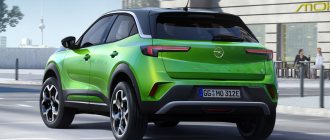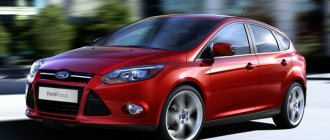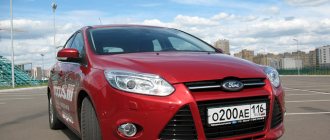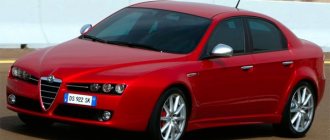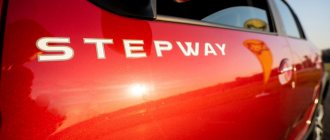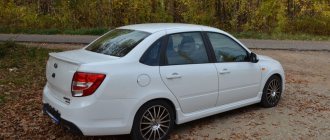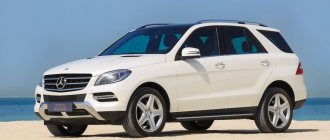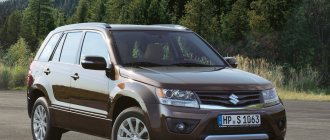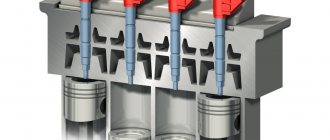The highlight of my December trip from Moscow to Crimea in a Peugeot 4008 was an SMS from my wife: “Where are you?” At night, having gotten lost, not without the help of a navigator, in the vastness of the Crimean steppes, I myself would have been willing to know the answer to this question... And yet it was an amazing voyage! In just four days, we smoothly moved from winter to summer and were able to test cars in a wide variety of weather and road conditions.
So, in order.
Day one: Moscow – Kyiv (870 km)
Actually, I also had a “zero” test day - I received the car at the Peugeot dealership on the eve of departure. I have long liked the appearance of the crossovers of the Japanese-French “trinity” (Mitsubishi ASX, Citroen Aircross and Peugeot 4008), and I was sincerely glad that I finally had the opportunity to “try on” at least one of them.
The “suit” turned out to be... a couple of sizes larger than I expected. It seems that the car is compact on the outside, but almost spacious on the inside! I immediately lower the seat as far as possible and immediately hit a small ergonomic miscalculation. The fact is that when the chair is lowered, the backrest leans back, and it is impossible to return it to a comfortable position (close to vertical). You have to move closer to the steering wheel or “pull” it towards you (the steering wheel is adjustable both in height and reach). Also, the lateral support of the chair is rather weak, although the bolsters on both the back and the pillow appear to be well developed. Well, to top it off, it turned out that the power window control keys are not illuminated on either the driver’s or passenger doors. No, on the driver's “remote” there is one key with a barely noticeable glowing indicator. But the rest have to be used by touch - like the joystick for adjusting the mirrors and the central locking button.
Should I start describing my impressions of the car with complaints about it? Perhaps not - unless it is noted that these were almost ALL complaints. Otherwise, I liked the Peugeot 4008, and in some respects I REALLY liked it.
The morning of the start day turned out to be snowy. The snow fell all night, pretty much dusting the car in the parking lot, and covering the streets with a thick slush. I wonder if the M3 Ukraine highway has been cleared? No, it’s not cleaned... Having met at the starting point, we distribute navigators, walkie-talkies, brushes, packages of windshield washer fluid and energy drinks, and food for the road. We agree to move in a convoy, but it quickly dissipates: the traffic on the highway is heavy, and the road conditions couldn’t be worse.
We didn't refuel often. By the end of the first day of travel, the average fuel consumption was about 9 liters per 100 km. This is despite the fact that we were moving at high speeds, and at customs we had to warm up for a long time, running the engines at idle speed.
The snow stops falling only towards the border of the Moscow and Kaluga regions. But it apparently passed near Kaluga earlier, so the cars created ruts and powerful snow “parapets” on the highway. You have to overcome them at high speed, moving to the left to get ahead or overtake. Oh, how difficult it would be without a stabilization system! It works great, keeping the car on track and preventing it from “breaking”. And for greater reliability, using the “puck” for selecting the transmission mode, I set, of course, “4WD”. The electronic unit of the “Multi-Select” all-wheel drive system with a Haldex multi-disc center clutch (the design is borrowed from the Peugeot 4007), in this mode, when driving on a dry, flat road, 85 percent of the traction is transmitted to the front wheels, and 15 to the rear. In slippery areas, the ratio changes to 60:40. The hard clutch locking mode (“LOCK”) is not applicable on the highway: when you reach 40 km/h, the clutch automatically opens. But even in automatic “4WD” mode, the car behaves reliably even in such conditions and gives confidence to the driver.
In terms of power, overtaking is not particularly difficult for a crossover equipped with a two-liter gasoline engine producing 150 hp. With. The maximum speed of a car with a CVT (as in our situation) is 188 km/h, acceleration to “hundreds” from a standstill is about 12 seconds. And from the get-go, the car does not accelerate sluggishly; it seems that the torque characteristic is even from low speeds to the highest (in fact, the peak torque of 190 Nm occurs at 4200 rpm).
Closer to the Bryansk region, the snowfall finally stops, but the powerful pines of the Bryansk forests are all covered in a thick and beautiful white cover. Eh, I would like to stop and take pictures - but there’s no time: I have to catch the “Three Sisters” border crossing (or officially – “New Yurkovichi”). Despite the poor quality of roads in the Bryansk region, the car allows you to move at high speeds, demonstrating good directional stability and precise handling. The electric power steering has a pleasant heaviness at speed. Many test participants considered the suspension of the crossover to be stiff, but it seemed to me that it was very balanced. The reason for the difference in ratings lay in the size of the wheels: I got a car shod with 215/70 R16 tires, while the more “hard” versions had 225/55 R18 tires.
True, the passion for speed backfires on us: a few kilometers before the border crossing, two of us (including me) “caught” the traffic cops’ radar. Well, you will have to pay a fine upon your return. And the customs greeted us unkindly. On the Russian side, a half-kilometer line of trucks lined up towards her. But the problem is not the queue, but the fact that according to the rules, a car temporarily exported abroad must be brought back into Russia by the person who exported it. And under the terms of our test drive, other journalists will go back from Crimea to Moscow. And although our Peugeots aroused great interest among customs officers, nevertheless, it took at least an hour to resolve the formalities. Having pretty much frozen on the street while filling out documents in various booths and trailers, we again happily sat down in the warm and cozy interiors of our cars. There are still about 300 kilometers to Kyiv.
These turned out to be difficult kilometers! At first, after the border, the road is narrow, there are many trucks on it, going both in the same and in the opposite direction. The surface is of relatively high quality and perfectly clean (although the area around is thoroughly snowed), but in some places the roadway is a real skating rink. The ABS system reminded itself at the very first slightest press on the brake pedal. In general, we often had to slow down, because overtaking and passing were further complicated by stripes of thick fog, which became longer and denser as we approached the capital of Ukraine.
An attempt to turn on the fog lights was unsuccessful: it did not become brighter ahead. Later it turned out that they were simply tightly sealed with frozen, dirty snow.
During acceleration, ESP again actively helped - and even on desperately slippery sections, directional stability was maintained. And yet I didn’t want to take risks, especially on the territory of another state. Therefore, I tried, if possible, to stay within the speed limits indicated by road signs. Especially in populated areas.
The crossover suspension resiliently worked through numerous patches of the road surface. There are MacPherson struts installed at the front, and an independent multi-link at the rear. The quality of roads in the former Soviet republic is not ideal, but there are no huge potholes or potholes, and you can feel that repairs have been carried out everywhere. The road infrastructure pleased us with a large number of gas stations with cozy shops.
However, we rarely refueled. By the end of the first day of travel, the average fuel consumption was about 9 liters per 100 km. This is despite the fact that we were moving at high speeds, and at customs we had to warm up for a long time, running the engines at idle speed. An excellent indicator for a two-liter crossover with a CVT!
The air conditioning system with simple and logically grouped rotating control knobs perfectly warmed the interior when moving around the north of Ukraine (here the frost, paradoxically, stung much more noticeably than in Moscow).
The on-board computer modes are switched by a round button labeled “INFO” - but this button is not illuminated and, in addition, is hidden behind the steering wheel. You don’t immediately get used to finding it by touch with your left (!) hand.
Only in the fog did the mirrors become covered with frost, so I had to periodically turn on their heating. The mirrors here are large, “wide-format”, and they are the driver’s main hope when parking or other reverse maneuvers. There is parking sensors, but it works a little late (we managed to verify this by driving in reverse into the bushes), and there is no visual indication of approaching objects - only audio. A rearview video camera is not offered, and there is virtually no view through the glass of the fifth door - the glass is very small.
I arrived in Kyiv a little later than the main group - and to my surprise I noted that I was practically not tired from such a long journey. Moreover, I got used to the Peugeot 4008 interior so much that I gradually got the hang of... changing flash drives on the fly in the USB connector, which is located here in the armrest box between the front seats. However, you could also use CDs.
Peugeot 4008 is a beautiful, agile crossover
The model began production in 2012 and was born in this form thanks to the result of cooperation between Mitsubishi (Japan) and PSA Peugeot Citroen (France). The car received only an external body design from French developers, and the technical part (engine, chassis, etc.) was developed in Japan.
The crossover is based on the Mitsubishi ASX and Outlander XL. Its assembly takes place in France and in Okazaki (Japan). There are no questions about the build quality.
Thanks to its French appearance, the Peugeot 4008 may appeal to the fair half of humanity. Narrow headlights and a spectacular appearance attract the attention of girls and women. Therefore, if you become the owner of this car, you will be guaranteed female attention. But not only women will appreciate its appearance; on the road this car will also look dignified and impressive, attracting the views of others.
Interior:
The interior is quite spacious for the driver and front passenger. The seats are comfortable, and if their positions are properly adjusted, your back and body will not get tired on a long trip. The materials in the cabin are of good quality, pleasant to look and feel, the plastic is soft. The dashboard is very simple and informative. The steering wheel has a fairly thick rim with bulges for the hands. Therefore, your fingers will not become numb on a long journey.
There is not as much space in the rear seats as in the front, but it can accommodate two adults comfortably. It will be too crowded for three people. In the middle of the floor there is a small tunnel protruding. The trunk in the 4008 is small, enough to put 2-3 bags or several packages. It has hooks on the side walls for securing cargo.
The spare wheel is full-size and located under the floor. There are also recesses for a jack, tools and other things. A 5-liter container with washer fluid easily fits there vertically.
Interior noise insulation is better than in the Mitsubishi ASX, but overall it is “lame”. If you need complete silence, you will have to finish it additionally.
Gasoline engine 1.6 l, 115 hp. equipped with an Auto Stop & Go start-stop system, which turns off the engine in traffic jams and at stops, thereby achieving fuel savings. It’s a pity that in Russia there are no configurations with this unit.
For Russia, only a 2.0 liter gasoline engine with a power of 150 hp, 4B11, is available. It's atmospheric and does its job quite well. Works in conjunction with a manual transmission or CVT.
With a manual transmission, the car behaves quite briskly, which is felt when accelerating and changing gears. The switching itself is easy. However, the backstage travel is quite large, the gears are located “widely”. It responds to pressing the gas pedal without delay. The gas and clutch pedals are very easy to press. The brake pedal is sensitive, with the slightest pressure on it the brakes come into action.
With a CVT at low speed, the acceleration dynamics are not very good. The engine develops higher and higher speeds, and the variator smoothly begins to accelerate the car. But at a speed of 60 km/h or more, the car continues to confidently accelerate up to 130-140 km/h, and there are no delays in shifting gears.
Clearance:
In the city, thanks to a ground clearance of 21 cm, the Peugeot 4008 easily climbs onto the sides and copes with road obstacles in the form of snow mounds left by snow removal equipment. The steering wheel turns very easily, the length of the body is short, so it’s convenient to turn around in tight yards and parking lots. True, visibility through the rear window is poor, so a rear view camera and parking sensors help.
winter , the cabin is very warm, the climate control system works well, and hot air blows from the air ducts on a warm engine.
Headlights are available in either halogen or xenon versions. Even the halogen headlights shine quite brightly; there are no problems with visibility when driving at night. During the day, instead of headlights, you can use daytime running lights (DRLs), which are made in the form of LEDs. Headlight washers are automatic and use a fairly large amount of windshield washer fluid. But they only work when the low beam is on, so when driving during the day with DRLs, fluid consumption is minimal.
On the highway, the crossover holds steady and turns confidently. When passing a series of bumps at high speed, body sway may occur. Easily picks up speed of about 150 km/h. Overtaking in the version with a CVT is accomplished with effort; the manual mode and the use of steering wheel paddles are very helpful. When you press the negative petal, the variator selects the desired operating mode and the dynamics for overtaking appear. To return to normal mode, you need to press and hold the positive paddle.
The suspension is moderately stiff, small bumps are felt quite well. You need to be careful on large bumps; when going over them, there may be breakdowns of the shock absorbers.
The all-wheel drive system uses a Haldex multi-plate clutch.
Riding modes:
- 2WD - front wheels driven (for dry asphalt, fuel economy)
- 4WD - full automatic drive (stability, safety)
- 4WD LOCK - rear wheel torque is 1.5 times greater than in 4WD (low speed driving for mud, sand and snow)
If you plan frequent trips into nature and trips off asphalt, it is better to choose a configuration with a manual transmission, because the variator does not like heavy loads (for example, when driving uphill). In 4WD LOCK , the car is quite passable, but the stabilization system should be turned off. Light dirt, rolled snow, ups and downs, country roads - the crossover can cope with such obstacles in all-wheel drive mode without any problems. It is better not to drive into difficult places, because you can get stuck.
The HSA electronic assistance system will help when starting off on hills. Its action is to hold the brake pedal for 2 seconds after you release it. Thus, the car will not roll back while you move your foot from the brake pedal to the gas pedal.
Also in the 4008th there is an emergency braking system and brake force distribution, which make braking more effective and safe.
Summary : a beautiful all-terrain vehicle for wealthy people.
Will appeal to : lovers of urban maneuverable driving with trips to nature and recreation, women.
Dislikes : lovers of off-road adventures, lovers of a sporty driving style.
| Advantages: | Flaws: |
|
|
Day two: Kyiv – New World (about 900 km)
In the morning I again find myself feeling almost no fatigue after an almost 12-hour drive. Will there be something today? The weather in the Ukrainian capital is clear but frosty. We start around noon. To be honest, I wanted to stay in Kyiv, it has changed so much in the 5-6 years in which I did not visit it. Many ultra-modern buildings have appeared, among which houses that were considered high-rise buildings in Soviet times are simply lost. Surely it would be possible to find interesting points for photographing the Peugeot 4008 - but the organizers of the trip promise an incredibly exciting program in Crimea, so we still leave the city, getting out onto the highway leading in the direction of Odessa.
From the spot to the quarry! The leaders of the column immediately set the speed limit at 140-150 km/h, in some places we accelerate to 160. The highway is free, the surface is high-quality and clean. True, the edges of the roadway are a little icy closer to the dividing strip and to the roadsides, you have to carefully monitor this when overtaking so as not to drive your left wheels onto the bare ice. Local traffic police posts are rare, so we fly quickly and in unison until the turn to Nikolaev.
By the way, the “enhanced” speed limit has a very significant effect on fuel consumption. After the next refueling, we reset the flow meters and enthusiastically exchange on the radio who managed to “squeeze out” how much. I got it... 22 liters per “hundred”! However, by the turn to Nikolaev, everyone’s numbers stabilized at around 16 hp. Well, if you like to ride fast, love and pay! In passing, we note that fuel in the republic is slightly cheaper than in Russia. Especially diesel. Unfortunately, the Peugeot 4008 comes to us only with a two-liter gasoline engine.
You can climb the plateau, the edge of which is formed by the White Rock, by car, but only with “crossover” ground clearance. By the way, its size in the Peugeot 4008 is a serious 210 mm.
Gasoline consumption indicators can be displayed on the on-board computer screen. Its display is located between the speedometer and tachometer scales and has excellent graphics. You can also evaluate your own “efficiency” using an indicator that displays instantaneous consumption. It is especially obvious when using the manual mode of the variator, but we will talk about it a little later. And now I would like to point out another small drawback of ergonomics. The on-board computer modes are switched by a round button labeled “INFO” - but this button is not illuminated and, in addition, is hidden behind the steering wheel. You don’t immediately get used to finding it by touch with your left (!) hand. The manufacturer should have found a more visible place for it.
In the Nikolaev area it is no longer winter, but a cool off-season. The temperature is slightly above zero, there is no snow, but a strong wind is blowing. The road is clean and level, but there are a lot of cars, and overtaking is often hampered by solid marking lines. There are also ambushes by local traffic guards; oncoming drivers warn about them by flashing their headlights with high beams. One of the participants in our test drive was unlucky: he was pulled over for speeding. As he later said, he managed to disperse for free. But the sediment, as they say, remained.
The next gas station, we are all together again - and almost immediately after it we get “lost” again due to the inability to simultaneously overtake a long column of trucks. After some time, the road, having bypassed Nikolaev, turns into a real autobahn with excellent coverage, clear markings and even special shields over the dividing fence that allow you to drive with high beams! It must be said that the low beam of the 4008’s xenon headlights cuts through the darkness superbly, and the visibility with the high beam is simply a delight. I’m flying at full speed, but I can’t catch up with our convoy; no one can hear me on the radio. And this plays a cruel joke on me.
In the Kherson area, I understand that the navigator is trying to take me to Crimea and then to Sudak and the New World through... Melitopol. Yes, this is a detour of 100-150 kilometers! Therefore, contrary to the advice of the electronic “prompter,” I turn onto the highway leading to Krasnoperekopsk and further to Simferopol. However, the navigator’s “voice” constantly pushes me to turn left, and in the end I give up: I go into the steppe. Surprisingly, the asphalt here is not bad, but it’s somehow very dark and deserted around, there are no signs, only lights are visible on the horizon. Where I am? It was at this moment that I received an SMS from my wife: “Where are you?” What should I answer her? I only know for sure that somewhere in Crimea...
My colleague starts to “light up” from the first kilometers, throwing the car from turn to turn and using exclusively the manual mode of the variator. Its six gears are conveniently selected using metal paddle shifters.
After about half an hour, my electronic “Susanin” took me to some railroad tracks in a place where there was no crossing and, most importantly, no road beyond the rails. I had to re-plan the route, and soon I got out onto the highway leading towards Feodosia and Sudak. But the adventures didn't end there. Suddenly, the navigator commanded “Now turn right!”, and... a bumpy dirt road immediately appeared under the wheels! Having decided not to argue with the electronics any longer, I moved briskly along it, at the same time listening to the operation of the suspension. Rattling slightly, it nevertheless made it possible to bounce elastically over pits and hillocks. The road led me to some village without a name, and beyond it... no, it didn’t end, but suddenly it became much smoother. Miracles... As I realized later, after looking at a paper map, the “smart” device helped me cut off a fair chunk of the highway.
But the tests continued! We had to literally search for the village of Novy Svet by the stars: the navigator did not know such a settlement. It’s good that there were several signs in his direction in Sudak. The last kilometers before the finish line turned out to be a real serpentine road, which, no matter how tired I wanted to sleep, I still overcame in the manual mode of the variator. And I really liked this mode. In particular, it made it possible to almost not use the brake pedal, but to effectively brake the engine. By moving the selector between the second and third virtual gears (there are six of them in total), I successfully reached the “finish line”.
Day four: New World – White Rock – “old” road – New World (about 250 km)
In the morning we meet jeepers from the Kyiv “Off-Road Adventure Club”. Today is our day of testing the 4008s on rough terrain, and we will be accompanied by guys in Nissan Patrol and Land Rover Defender. These vehicles are “armed” to the roof with winches, hi-jacks, sand trucks and other special equipment. Oh, all this wouldn’t be useful for rescuing our crossovers from various troubles...
No, nothing was useful. We simply looked at Crimea, so to speak, “from the inside”, and not from the “edge” facing the sea. The “mainland” part of the peninsula, as it turned out, is no less interesting than the sea coast, which is well known to many! The White Rock, but in fact a whole ridge of whitish limestone, rises above the village of the same name not far from the city, again with the “speaking” name of Belogorsk. You can climb up by car, but only with “crossover” ground clearance. By the way, its size in the Peugeot 4008 is a serious 210 mm.
The “babies” crawled onto the plateau above the rock without much difficulty, in a cheerful train. The help of jeepers was not needed, except that our guides acted as signalmen several times, showing how to get through the most difficult places. Of course, we all blocked the center couplings in advance by moving the mode selection “washers” to the “LOCK” position (permanent all-wheel drive mode). In this case, according to the “passport”, from 50 to 82 percent of the torque is supplied to the rear axle, which is very helpful when driving at low speeds in mud, sand or snow. Additionally, ESP improves cross-country ability by braking a wheel that has slipped. We were not able to encounter such situations: the track in the mountains turned out to be dense, only studded with stones. There was no sand or dirt. The main thing was not to run into protruding cobblestones with your “belly” (the standard “protection” of the units in the engine compartment is only a small area).
The view from the top of the White Rock is stunning: it seems as if you are standing on the shore of a suddenly retreating sea. We took pictures a little in a hurry: the “climbing” had to be completed ahead of schedule due to the beginning of rain. It’s a pity that we didn’t spend yesterday here, warm, dry and clear - almost like a summer day...
After lunch in a cafe on the Simferopol - Sudak highway, we return to the sea along a very old road, in fact, a horse trail. There is no covering here, only stones driven into the ground. In some places it is difficult for two cars to pass each other, in others they cannot pass each other at all. Our crossovers, “clicking” with the exchange rate stability and ABS systems, do not move, but crawl on wet clay and stones. What views around! Alas, although the weather here is almost summer (+12 degrees), it is winter and it gets dark early, so it’s not possible to have a colorful photo shoot.
We get out onto the already familiar coastal highway in complete darkness. Hmmm, I was less lucky: the serpentine road on which my colleague had been “rocking” the day before is now not only dark, but also wet. Along the way, I note the good work of the washer: when you press the steering column lever, the liquid is supplied SIMULTANEOUSLY to both the headlights and the glass (several times I came across cars in which the headlights were washed first, and then - with a delay - the windshield, and this was inconvenient and even unpleasant). I also liked that the air conditioner did its job well: it instantly “cleaned” the glass from condensation that formed in warm and humid weather.
Well, the review is guaranteed, let's go, but, of course, not at the same pace as yesterday. And I don’t turn off the stabilization system. Besides, after a hearty lunch you really want to sleep. This is what my partner is doing, lounging in the next chair. He woke up only near Sudak, which means that the Peugeot 4008 is capable of moving not only quickly (we were not at all behind the column), but also smoothly, providing passengers with comfort and coziness.
Naturally, I also drove the car along serpentine roads, using the manual mode of the variator and almost without touching the brake pedal. But out of habit, I switched gears with the selector, and not with the steering wheel paddles. And at the same time I noted that this selector is a little short, you have to reach for it slightly. But the variator chooses gears honestly, in each one you can spin the engine to the red zone of the tachometer.
Technical characteristics of Peugeot 4008:
Class - crossover Body - SUV Drive - front or all-wheel drive, plug-in, rear Haldex multi-plate clutch Engine location - transverse Engine 1 - 4B11, petrol, 4 cylinders in line, 2.0 l, 150 hp, 2012 onwards. Engine 2 - NKZ, petrol, 4 cylinders in line, 1.6 l, 115 hp, AS&G, 2012. Engine 3 - 9HD, diesel, 4 cylinders in line, 1.6 l, 110 hp, 2012. Engine 4 - 6HZ, diesel, 4 cylinders in line, 1.8 l, 150 hp, 2012. Volume - 2 l Power - 150 hp Torque 1 - 199 Nm, 4200 rpm Torque 2 - 154 Nm, 4000 rpm Torque 3 - 270 Nm, 1750 rpm Torque 4 - 300 Nm, 2000-3000 rpm Number of valves - 16
Compression ratio - 10.5 Fuel injection 1 - distributed, multipoint Fuel injection 2 - distributed, multipoint Fuel injection 3 - direct Fuel injection 4 - direct Timing drive - chain, MIVEC gearbox system 1 - mechanical, 5-speed. Gearbox 2 — continuously variable CVT, 6 ranges, manual mode, paddle shifters Number of seats — 5 Fuel tank — 60 liters Fuel — AI-95 gasoline or diesel Fuel consumption (city) — 10.3 l/100 km Fuel consumption (highway) — 6.5 l/100 km Acceleration to 100 km/h — 9.9-10.9 seconds Maximum speed — 188-198 km/h
Dimensions:
Length, width, height - 4340 x 1800-2125 x 1625-1635 mm (without/with mirrors, without/with roof rails) Wheelbase - 2670 mm Front track - 1545 mm Rear track - 1540 mm Turning circle - 10.6 m Curb weight - 1380-1570 kg Unloaded weight - 1305-1495 kg Gross weight - 1870-2060 kg Trailer weight - 1100-1400 kg with brakes, 685-750 kg without brakes Recommended towbar load - 55-70 kg Trunk volume - 416 liters, with seats folded - 1219 l Battery capacity and type - 55-65 Ah, reverse polarity Tire size - R16 215/70 or R18 225/55 Wheel size and type - 6.5 x 16 (Access option), 7 x 18 (Active option), light alloy or steel (3 styles)
Driving performance:
Ground clearance - 210 mm Approach angle - 19 degrees Departure angle - 31 degrees
Comfort:
Air conditioning (Access). Climate control (Active, Allure). Cruise control (Active, Allure). The steering wheel is electric power steering. Engine start - button (Allure). Front seats - heated, manual or electrically adjustable. Rear seats - center armrest (Active, Allure). Window lifters - electric, 4 pieces, driver's with closer. Rearview mirror - auto-dimming (Active, Allure option). Side mirrors are heated, electrically positioned and folded. Headlights - auto-on.
Suspension:
Front - independent, McPherson strut, anti-roll bar. Rear - independent, multi-link, anti-roll bar. The shock absorbers are gas-filled.
Brake system:
Front brakes are disc, ventilated. Rear brakes are disc. ABS.
Body:
The roof is glass, panoramic, LED backlit (Active, Allure options). The windshield is athermal (Active, Allure). Radiator - chrome grille surround (Active, Allure). Rails - on the roof (Active, Allure).
Safety:
Package - adaptation to Russia. Alarm – volume sensor, perimeter sensor (Active option, Allure option). Central locking. The immobilizer is electronic. Access - keyless (Allure). Airbags - 7 pieces, 2 front (passenger can be switched off), 2 in the backs of the front seats, 2 side curtains for the front and rear, driver's knee (Active, Allure). Belts - three-point, pretensioners, force limiters (Active, Allure option). Protection - crankcase, stiffening ribs on the hood.
Equipment:
The on-board computer is in Russian. Headlights 1 - halogen (Access, Active), LED DRL lights (Active, Allure). Headlights 2 - xenon, auto-correction (Active, Allure option). Headlight washer (Active, Allure). Fog lights - front (Active, Allure). Parking - rear view camera, 4 front and 4 rear sensors (Active, Allure option). Sensors - light and rain (Active, Allure). Sockets - 12 V in the center armrest.
Salon:
Steering wheel - audio control buttons (Active, Allure). The steering wheel and gearshift lever are made of leather (Active, Allure). Audio 1 - radio, CD, MP3, Bluetooth, USB, AUX, 4 speakers, steering wheel control (Access, Active). Audio 2 - high quality, Hi-Fi Rockford Fosgate, amplifier, 8 speakers + subwoofer (Allure). Display - LCD, monochrome (Access, Active), color (Allure). The glove box is cooled. Seats - fabric (Access), fabric-leather (Active), leather (Allure).
Electronic systems:
- ABS
- dynamic stabilization ASC (switchable)
- TCL traction control
- start-stop AS&G
- hill start HSA
- EBD brake force distribution
- emergency braking BA
Prices depending on configurations:
Access - petrol, 2.0 l, 150 hp, 5-speed manual transmission, 4WD - RUB 999,000 . Access - petrol, 2.0 l, 150 hp, CVT 6-speed. — 1,039,000 rub . Active - petrol, 2.0 l, 150 hp, 5-speed manual transmission, 4WD - RUB 1,099,000 . Active - petrol, 2.0 l, 150 hp, CVT 6-speed. — 1,139,000 rub . Allure - petrol, 2.0 l, 150 hp, CVT 6-speed. — 1,189,000 rub .
Prices for new cars are indicated for information and are not a public offer.
If you don’t have enough to buy a new one, a used Peugeot 4008 can be found through advertisements on regional and thematic websites. Prices vary depending on the age of the car; their relationship can be seen in the diagram:
THAT:
The recommended maintenance interval is every 15,000 km or once a year.
Approximate prices for maintenance (work + spare parts):
TO-1 — 9,000 rub. TO-2 — 15,000 rub. TO-3 - 10,000 rub. TO-4 — 19,000 rub.
Filling volumes and containers
Engine oil in the engine:
petrol, 2.9 l, 150 hp - 4.3 l. petrol, 1.6 l, 115 hp - 4.2 l. diesel, 1.6 l, 110 hp — 3.75 l. diesel, 1.8 l, 150 hp - 5.3 l.
Operating manuals download:
2012-2014 — instruction manual in Russian
Photos:
Day five: New World – Simferopol – plane – Moscow
At the airport of the capital of Crimea, I regretfully say goodbye to my little gray lion cub. I really fell in love with him during the test. And he deservedly fell in love: over more than two thousand miles, we have been with him in a variety of conditions, and none of them turned out to be unsuitable for him. Likewise, the performance of each of the systems turned out to be excellent. I liked the dynamics, the comfort, and the elastic, precise steering with a powerful reactive action. The efficiency was also memorable: by the end of the trip, the average consumption of 95 gasoline again returned to the mark of 10 liters per “hundred”.
For me, there are only two things missing from this car: a diesel engine and a larger trunk. The Peugeot 4008 offers just 416 liters of cargo space (which can be increased to 1,220 liters by folding the rear seats). The volume could have been larger, but, alas, part of it had to be sacrificed for a full-size spare wheel.
What is the “issue price”? Various versions of the 4008 cost in Russia from 940 thousand to 1.26 million rubles. But there are few versions: there is only one engine (2.0 l, 150 hp), and two gearboxes (five-speed manual and continuously variable transmission with six virtual “gears”).
Drive is all-wheel drive only. The top Allure trim offers, among other things, xenon headlights, a push-button engine start system, LED daytime running lights, leather trim, and 18-inch alloy wheels. But it seems that on cheaper 16-inch wheels with higher-profile tires the car runs smoother and softer, and therefore, it’s quite possible that you shouldn’t buy additional 18-inch wheels if the version you like doesn’t have them.
But what you should be concerned about is additional protection for the engine compartment.
If not from stones and bumps on the roads, then at least from the dirt that readily flies into the “engine room”. By the way, a quick inspection of the engine compartment showed that it is not organized typically for a “Frenchman”: nothing tricky, no “frills”, all units and devices are in plain sight. And this is also a plus. Author Andrey Ladygin, columnist of the portal “MotorPage” Edition MotorPage.Ru Photo photo by the author
Test drive Peugeot 4008 from Drom.ru. Clone
Testing identical cars produced by different companies is a thankless task. We talked about the Mitsubishi ASX in detail at one time, and now it’s time to talk about this car again, but in a slightly different way. Today we will check the homework of a French company in adapting a Japanese car to European requirements and aesthetic standards. We will look for differences and improvements. Meet the brother of the Citroen C4 Aircross and Mitsubishi ASX - Peugeot 4008. Meeting place - Carpathians.The materiel in the case of this trinity will not be long. Essentially, the car is the same. But there are, of course, nuances. The list of improvements carried out by the French includes a radical change in appearance, new touches in the interior design, improved sound insulation, and reconfiguration of the suspension and steering. Were these measures enough to give the Peugeot 4008 an individual face? Let's watch...
It's better to look from the front. There is nothing here that reminds us of the Japanese origin of the car. French designers managed to subtly and organically carry out a face change operation. The 4008th is the flesh of Peugeot of the new wave, made in the company’s corporate style from bow to stern. He looks much more interesting than his Japanese brother. Moreover, this also applies to the rear view, where the French even changed the shape of the windows.
The car sits on spectacular 18-inch wheels. The 4008 has an original fifth door. Accordingly, the wings too. It turns out that the body of the 4008 is similar to the ASX only in the doorways and roof. In general, I personally have no complaints about the appearance of the new “fawn”. It turned out bright and beautiful. What's inside?
The mood inside is different. Here, apparently, people counting hard coins intervened in the conversation. It seemed financially impractical to them to completely remodel the ASX interior. Therefore, the improvements are cosmetic in nature. Nice three-spoke steering wheel with mixed leather, black lacquer finish...
In principle, the ASX's finishing materials weren't that bad. I found them here too. The dashboard has elastic plastic with a nice texture. The doors have a similar material texture, but only the top thin layer is soft. It turns out to be something like artificial leather. In principle, it feels quite pleasant to the touch.
In general, the interior looks good at first glance, but if you take a closer look, budget Japanese solutions, and besides, not the first freshness, catch your eye. For example, the simple “twists” of the ventilation system that look alien in such a nice and seemingly European car, or the small digital display crowning the center console. The devices are 100% made by Mitsubishi - the same ones found on the Outlander XL. In wells, they look and read well. Between them is a color screen of the on-board computer. This is the lot of the top version of Allure.
